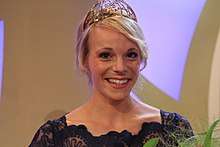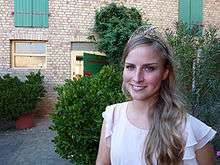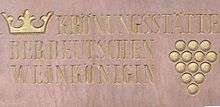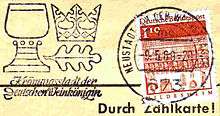German Wine Queen
The German Wine Queen (German: Deutsche Weinkönigin) is the representative of the German wine industry. She is elected, usually in the Palatine town of Neustadt an der Weinstraße, for a period of one year.[1][2] The title is competed for by the regional wine queens of the thirteen German wine regions producing "quality" wine.



The 71st German Wine Queen is Angelina Vogt from Weinsheim in the Nahe region;[3] she was chosen on 27 September 2019 for the period 2019/2020.
History
Beginnings
In 1931 the first German wine region, the Palatinate, crowned its own wine queen. The idea for this "Palatine Wine Queen" came from publisher, Daniel Meininger. At his suggestion, Ruth Bachrodt (later Theysohn) was elected. She came from Pirmasens in Western Palatinate where, in fact, no wine is produced.[4] Her successor, Cecily Seitz, was elected in 1932 by popular request. In 1933, control of the festival was taken over by Nazi leaders. Until the beginning of the Second World War, the official Gau Photographer sought out the "prettiest young woman associated with the wine industry" on behalf of the very popular Gauleiter of the Palatinate, Joseph Buerckel.
Because the Palatine Wine Queen was Germany's only wine queen, she automatically represented the German wine industry in general as well as the Palatine wine region until 1939, and then again, from 1947 until 1949. In 1949, there was still only one competition but, following the election, Elisabeth Kuhn, later Gies from Diedesfeld, was officially nominated as the German Wine Queen, so that she officially became both the Palatine and German Wine Queen in the same year.[4]
Criteria for candidates
Since 1950, the German Wine Queen has been elected in a separate competition. Each year, every recognized German wine region selects its local wine queen. From these regional wine queens, the German Wine Queen is chosen the following year. Until 1999, it was a condition that the candidates had to be single - they could be neither married nor divorced - and had to come from a family of winemakers. Since 2000, the candidates who apply have only had to have "clear and strong ties with German wines," demonstrated by "appropriate wine-related training and / or a family relationship with the local wine production and / or the qualification as an area wine queen". In addition, applicants must be at least 18 years old on the day of election.[5]
Changing requirements
For about 30 years the wine queens represented the traditional image of the pretty and virtuous maiden in traditional costume, the only significant change being in 1966 when the original sceptre was replaced by a wine glass. As the newspaper, Süddeutsche Zeitung, said in 1950, the candidates were "true daughters of the vineyards, they were of powerful build, healthy and wholesome". Their assessment, at that time, included performing a waltz and giving a speech.[6] Until the late 1950s, the ceremonial duties of the German Wine Queen were mainly restricted to domestic markets. There were appearances at wine festivals during Green Week and at social events such as the awarding of the German Wine Culture Prize. Trips abroad, such as to Belgium (Irmgard Mohler) or to Spain (Wilma Seyer, later Scholl) remained the exception. However, the then Foreign Minister, Heinrich von Brentano, recognized the diplomatic potential for the image of the young federal republic, when he presented Wilma Seyer at the "Diplomats' Wine Festival" in Eberbach Monastery that he had initiated. By the following year, the Palatine, later German, Wine Queen, Christel Koch, traveled to the USA, the first time a wine queen from Germany had done so.
In the 1980s the image of the Wine Queen in public began to fundamentally change, especially with the election of personalities such as Karin Molitor (1982/83) and Petra Mayer (1988/89). In 1981 the wearing of the dirndl, the traditional dress that had been obligatory for photo calls, was scrapped. From the 1990s, it changed from being a role for young women vintners or those who were linked to the wine trade, to being a career springboard into politics (Julia Klöckner), into marketing (Katja Schweder, Evelyn Schmidt), into gastronomy (Carina Dostert) or starting small businesses (Sandra Hake, Sylvia Benzinger). Selection is no longer based so much on good looks and dancing skills today; more important, in addition to a knowledge of oenology and winemaking technology, quick wit and eloquence are required as well as proficiency in foreign languages and a knowledge of the export business.[6] As a result, a preparatory seminar for the candidates was introduced in Neustadt an der Weinstraße in 2009.[1]
Selection
Venue


The German Wine Queen competition is arranged by the German Wine Institute (DWI) whose head office is in Bodenheim.[7] It is traditionally held in the Saalbau festival hall in Neustadt on the occasion of the German Wine Harvest Festival on the Friday of the second festival week in October. However, the venue can be changed on important occasions. In addition to Neustadt an der Weinstraße, other venues have been:
- 1952 Freiburg im Breisgau
- 1954 Heilbronn
- 1957 Würzburg
- 1960 Bad Dürkheim
- 1963, 2016 Mainz
- 1966 Stuttgart
- 1969 Offenburg
- 1972 Stuttgart
- 1975 Stuttgart
- 1984 Trier
- 1988 Berlin
- 1993 Bad Neuenahr-Ahrweiler
- 1998 Freyburg (Unstrut)
- 2006 Dresden (800th anniversary of the city, the most important place in the Saxon wine region)
- 2009 Heilbronn
- In May 2009, the DWI and the Mayor of Neustadt an der Weinstraße signed a contract that stipulates Neustadt as the coronation venue until 2020. This rule may be waived no more than three times per decade, "to give other German wine regions the opportunity to host the coronation in order to respond to special events and celebrations."[1][2]
- 2013 Offenburg, Oberrheinhalle; preliminary round on 7 September; final round for the six remaining regional queens on 13 September.
Election process
In recent times the election process has changed several times. In 2009, for the first time, the competition was broadcast on a large screen outside the venue. In the first round, 12 of the 13 regional wine queens faced a rigorous oral examination with questions about viticultural and winemaking techniques, as well as wine labelling, packaging and marketing, from a panel of 80 judges. In addition each candidate had to assist - in English - a "confused foreign tourist" visiting Germany's wine country. Only six candidates went through to the second and final round, a televised "gala" attended by 1,300 guests and watched by more than a million viewers, where the 18- to 25-year-olds had to demonstrate they could field questions on wine-making spontaneously. After the competition, the newly elected wine queen and her two princesses were invited by the Minister for Agriculture and the town of Heilbronn to a festival banquet, the so-called "After-Show Party".[8][9]
During their one-year term of office, the Wine Queen and Wine Princesses advertise German wine at trade fairs, wine festivals and other events. The Wine Queen, in particular, is the ambassador of German wine-growers and their products at some 250 appearances in Germany and abroad.[9][10]
Results
German wine queens since 1949
The following table lists all German wine queens since 1949:[11]
| # | Year | Wine Queen | Born/died | Age when elected | Wine region | Town of origin |
|---|---|---|---|---|---|---|
| 1. | 1949/1950 | Elisabeth Kuhn, later Gies | 1930–2012 | 19 | Palatinate | Diedesfeld |
| 2. | 1950/1951 | Marie-Elisabeth Pütz, later Steffen | 1925 | 25 | Moselle-Saar-Ruwer (since 2006 Moselle) | Saarburg |
| 3. | 1951/1952 | Gisela Koch | Mittelrhein | St. Goarshausen | ||
| 4. | 1952/1953 | Elisabeth Huber | Baden | Neuweier | ||
| 5. | 1953/1954 | Mathilde Machwirth | Nahe | Guldental | ||
| 6. | 1954/1955 | Erika Hofmann | Rheinhessen | St. Johann | ||
| 7. | 1955/1956 | Irmgard Mohler | 1937–1981 | 18 | Palatinate | Bad Bergzabern |
| 8. | 1956/1957 | Margret Hoffranzen, later Wilmes | ?–2002 | Moselle-Saar-Ruwer | Mehring (Moselle) | |
| 9. | 1957/1958 | Karoline Hartmann | 18 | Franconia | Rödelsee | |
| 10. | 1958/1959 | Rosemarie Schreck | 24 | Franconia | Klingenberg | |
| 11. | 1959/1960 | Wilma Seyer, later Scholl | 1939 | 20 | Rheingau | Kiedrich |
| 12. | 1960/1961 | Christel Koch | 18 | Palatinate | Ungstein | |
| 13. | 1961/1962 | Marlies Kaiser | 22 | Rheinhessen | Dintesheim | |
| 14. | 1962/1963 | Marita Heinzen, later Schmitz | 19 | Ahr | Ahrweiler | |
| 15. | 1963/1964 | Inge Schwaab, later Heidenreich | Moselle-Saar-Ruwer | Zeltingen | ||
| 16. | 1964/1965 | Marita Bäuerlein | 20 | Franconia | Volkach | |
| 17. | 1965/1966 | Waltraud Hey | 19 | Palatinate | Oberotterbach | |
| 18. | 1966/1967 | Ilse Theobald | 22 | Nahe | Hochstätten | |
| 19. | 1967/1968 | Ruth Collet, later Kutz | Moselle-Saar-Ruwer | Reil | ||
| 20. | 1968/1969 | Brigitte Wolf | 21 | Franconia | Veitshöchheim | |
| 21. | 1969/1970 | Marika Gebhardt | 19 | Rheingau | Martinsthal | |
| 22. | 1970/1971 | Erika Sinß | 18 | Nahe | Windesheim | |
| 23. | 1971/1972 | Ruth Kröther | 20 | Palatinate | Freinsheim | |
| 24. | 1972/1973 | Ulrike Seyffardt, later Neradt | 1951 | Rheingau | Martinsthal | |
| 25. | 1973/1974 | Ingrid Kurth | 21 | Ahr | Bad Neuenahr-Ahrweiler | |
| 26. | 1974/1975 | Doris Emmerich | 1954 | 20 | Nahe | Waldböckelheim |
| 27. | 1975/1976 | Edelgard Bauer | 1955 | 20 | Nahe | Kirschroth |
| 28. | 1976/1977 | Friedlinde Gurr, later Gurr-Hirsch | 1954 | 22 | Württemberg | Untergruppenbach |
| 29. | 1977/1978 | Gisela Faber | Baden | Freiburg im Breisgau | ||
| 30. | 1978/1979 | Heike Schmitt | 19 | Rheinhessen | Nierstein | |
| 31. | 1979/1980 | Rita Moog, later Moog-Fischer | Moselle-Saar-Ruwer | Valwig | ||
| 32. | 1980/1981 | Regine Usinger | 1958 | 22 | Rheinhessen | Nackenheim |
| 33. | 1981/1982 | Hildegard Weber | Palatinate | Gönnheim | ||
| 34. | 1982/1983 | Karin Molitor, later Molitor-Hartmann | 1962 | 20 | Franconia | Sommerach |
| 35. | 1983/1984 | Carola Geiger, later Geiger-Kaiser | 1962 | 21 | Württemberg | Weinsberg-Grantschen |
| 36. | 1984/1985 | Ursula Maur | Ahr | Mayschoß | ||
| 37. | 1985/1986 | Mechthild Meyer, later Weis | 1962 | 23 | Moselle-Saar-Ruwer | Waldrach |
| 38. | 1986/1987 | Helga Drauz, later Drauz-Oertel | 1967 | 19 | Württemberg | Heilbronn |
| 39. | 1987/1988 | Jutta Fassian, later Fassian-Emmrich | Moselle-Saar-Ruwer | Mehring (Moselle) | ||
| 40. | 1988/1989 | Petra Mayer | 1966 | 22 | Baden | Schliengen |
| 41. | 1989/1990 | Renate Schäfer | 1968 | 21 | Franconia | Astheim (Volkach) |
| 42. | 1990/1991 | Birgit Schehl, later Rebholz-Schehl | 1969 | 21 | Palatinate | Hainfeld (Palatinate) |
| 43. | 1991/1992 | Lydia Bollig, later Bollig-Strohm | 1970 | 21 | Moselle-Saar-Ruwer | Trittenheim |
| 44. | 1992/1993 | Astrid Bechtel | 1972 | 20 | Rheinhessen | Worms-Heppenheim |
| 45. | 1993/1994 | Sandra Hake, later Frölich | 1970 | 23 | Saale-Unstrut | Freyburg (Unstrut) |
| 46. | 1994/1995 | Ulrike Neymeyer | 1968 | 26 | Baden | Endingen am Kaiserstuhl |
| 47. | 1995/1996 | Julia Klöckner | 1972 | 23 | Nahe | Guldental |
| 48. | 1996/1997 | Ines Hoffmann | 1972 | 24 | Saxony | Dresden |
| 49. | 1997/1998 | Natascha Thoma, later Thoma-Widmann | 1971 | 26 | Baden | Ebringen |
| 50. | 1998/1999 | Susanne Völker, later Nett | 1974 | 24 | Rheinhessen | Oppenheim |
| 51. | 1999/2000 | Simone Renth, later Renth-Queins | 1973 | 26 | Rheinhessen | Schwabenheim an der Selz |
| 52. | 2000/2001 | Carina Dostert, later Curman | 1979 | 21 | Moselle-Saar-Ruwer | Nittel |
| 53. | 2001/2002 | Petra Gärtner | 1980 | 21 | Hessische Bergstraße | Zwingenberg (Bergstraße) |
| 54. | 2002/2003 | Judith Honrath | 1980 | 22 | Nahe | Langenlonsheim |
| 55. | 2003/2004 | Nicole Then | 1980 | 23 | Franconia | Sommerach |
| 56. | 2004/2005 | Petra Zimmermann | 1984 | 20 | Moselle-Saar-Ruwer | Temmels |
| 57. | 2005/2006 | Sylvia Benzinger, later Benzinger-Kugler | 1978 | 27 | Palatinate | Kirchheim an der Weinstraße |
| 58. | 2006/2007 | Katja Schweder | 1980 | 26 | Palatinate | Hochstadt (Palatinate) |
| 59. | 2007/2008 | Evelyn Schmidt | 1983 | 24 | Saxony | Radebeul |
| 60. | 2008/2009 | Marlies Dumbsky | 1985 | 23 | Franconia | Volkach |
| 61. | 2009/2010 | Sonja Christ, later Christ-Brendemühl | 1984 | 25 | Moselle | Oberfell |
| 62. | 2010/2011 | Mandy Großgarten | 1987 | 22 | Ahr | Dernau |
| 63. | 2011/2012 | Annika Strebel | 1987 | 23 | Rheinhessen | Wintersheim |
| 64. | 2012/2013 | Julia Bertram | 1989 | 22 | Ahr | Dernau |
| 65. | 2013/2014 | Nadine Poss | 1991 | 22 | Nahe | Windesheim |
| 66. | 2014/2015 | Janina Huhn | 1989 | 24 | Palatinate | Bad Dürkheim |
| 67. | 2015/2016 | Josefine Schlumberger | 1994 | 21 | Baden | Laufen (Sulzburg) |
| 68. | 2016/2017 | Lena Endesfelder | 1993 | 23 | Moselle | Mehring |
| 69. | 2017/2018 | Katharina Staab | 1990 | 27 | Nahe | Oberhausen an der Nahe |
| 70. | 2018/2019 | Carolin Klöckner | 1995 | 23 | Württemberg | Vaihingen an der Enz |
| 71. | 2019/2020 | Angelina Vogt | 1994 | 25 | Nahe | Weinsheim |
- Neustadt Vintage Festival parade: Float with Sonja Christ (Moselle wine region), the German Wine Queen 2009/10
 Evelyn Schmidt (2007/2008)
Evelyn Schmidt (2007/2008)- Katja Schweder (2006/2007)
 Sylvia Benzinger-Kugler (2005/2006)
Sylvia Benzinger-Kugler (2005/2006) Mechthild Meyer (1985/1986)
Mechthild Meyer (1985/1986)
Frequency of winners by wine region
| Wine region | Years | Number |
|---|---|---|
| Ahr | 1962, 1973, 1984, 2010, 2012 | 5 |
| Baden | 1952, 1977, 1988, 1994, 1997, 2015 | 6 |
| Franconia | 1957, 1958, 1964, 1968, 1982, 1989, 2003, 2008 | 8 |
| Hessische Bergstraße | 2001 | 1 |
| Middle Rhine | 1951 | 1 |
| Moselle (until 2005 Moselle-Saar-Ruwer) | 1950, 1956, 1963, 1967, 1979, 1985, 1987, 1991, 2000, 2004, 2009, 2016 | 12 |
| Nahe | 1953, 1966, 1970, 1974, 1975, 1995, 2002, 2013, 2017, 2019 | 10 |
| Palatinate | 1949, 1955, 1960, 1965, 1971, 1981, 1990, 2005, 2006, 2014 | 10 |
| Rheingau | 1959, 1969, 1972 | 3 |
| Rheinhessen | 1954, 1961, 1978, 1980, 1992, 1998, 1999, 2011 | 8 |
| Saale-Unstrut (participating since 1990) | 1993 | 1 |
| Saxony (participating since 1990) | 1996, 2007 | 2 |
| Württemberg | 1976, 1983, 1986, 2018 | 4 |
References
- "Neustadt bleibt weiter Krönungsstätte", Die Rheinpfalz (in German), Ludwigshafen, 2009-05-19
- "Einwurf: Werbewirksam", Die Rheinpfalz (in German), Ludwigshafen, 2009-05-19
- Deutsches Weininstitut GmbH (2019-10-06). "Die 71. Deutsche Weinkönigin heißt Angelina Vogt" (in German). Retrieved 2019-10-06.
- pfaelzische-weinkoenigin.de. "Historisches". Archived from the original on 2013-01-21. Retrieved 2012-09-13.
- Die Deutsche Weinkönigin at vinothek.wordpress.com. Retrieved 21 Oct 2013
- Gisela Kirschstein (2008-10-12), "Wein und Wissen", Die Welt (in German), Berlin accessed on 25 Sep 2012.
- Deutsches Weininstitut. "Veranstaltungskalender". Retrieved 2012-09-25.
- Gute Chancen für Württembergerin at www.stimme.de. Accessed on 8 Oct 2013
- Germany's 61st Wine Queen is Crowned Archived 2013-10-08 at Archive.today at www.germanwineusa.com. Accessed on 8 Oct 2013
- Die Weinhoheiten at www.wein-kunde.de. Retrieved 21 Oct 2013
- Deutsche Weinköniginnen seit 1949 Archived 2013-10-02 at the Wayback Machine at www.die-weinkiste.com. Accessed on 29 Sep 2013.
Literature
- Wolfgang Diehl (2005), Bacchuszug und Herbstschmüerel : Über Herbstbräuche in der Palatinate und einigen Nachbarregionen, Schriften zur Weingeschichte Nr. 151 (in German), Wiesbaden: Gesellschaft für Geschichte des Weines, ISSN 0302-0967
- Wolfgang Junglas (2008), 60 Jahre Deutsche Weinköniginnen (in German), Frankfurt am Main: Societäts-Verlag, ISBN 978-3-7973-1099-6
- Wolfgang Junglas u. a. (1998), Wein & Krone : 50 Jahre Deutsche Weinköniginnen 1949–1998 (in German), Ingelheim: projekt büro, ISBN 3-9805502-1-4
- Martina Weber (1989), "Die Weinköniginnen", Brauchforschung regional, Mainzer Studien zur Sprach- und Volksforschung Nr. 14 (in German), Wiesbaden, Stuttgart: Steiner Verlag, pp. 217–224, ISBN 9783515053686
External links
| Wikimedia Commons has media related to German Wine Queen. |